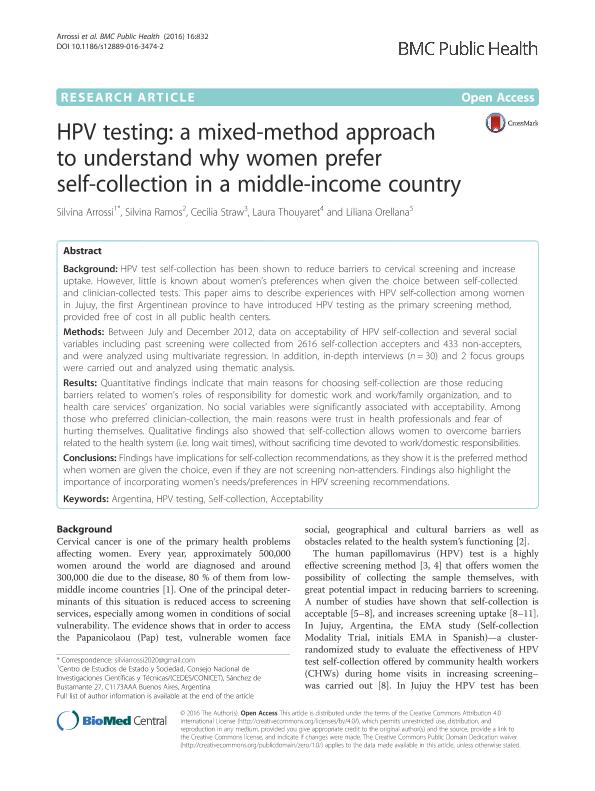Mostrar el registro sencillo del ítem
dc.contributor.author
Arrossi, Silvina

dc.contributor.author
Ramos, Silvina

dc.contributor.author
Straw, Cecilia

dc.contributor.author
Thouyaret, Laura
dc.contributor.author
Orellana, Liliana

dc.date.available
2018-05-28T20:14:09Z
dc.date.issued
2016-08
dc.identifier.citation
Arrossi, Silvina; Ramos, Silvina; Straw, Cecilia; Thouyaret, Laura; Orellana, Liliana; HPV testing: a mixed-method approach to understand why women prefer self-collection in a middle-income country; BioMed Central; BMC Public Health; 16; 832; 8-2016; 2-11
dc.identifier.issn
1471-2458
dc.identifier.uri
http://hdl.handle.net/11336/46332
dc.description.abstract
Background: HPV test self-collection has been shown to reduce barriers to cervical screening and increase uptake. However, little is known about women?s preferences when given the choice between self-collected and clinician-collected tests. This paper aims to describe experiences with HPV self-collection among women in Jujuy, the first Argentinean province to have introduced HPV testing as the primary screening method, provided free of cost in all public health centers.<br />Methods: Between July and December 2012, data on acceptability of HPV self-collection and several social variables including past screening were collected from 2616 self-collection accepters and 433 non-accepters, and were analyzed using multivariate regression. In addition, in-depth interviews (n = 30) and 2 focus groups<br />were carried out and analyzed using thematic analysis.<br />Results: Quantitative findings indicate that main reasons for choosing self-collection are those reducing barriers related to women?s roles of responsibility for domestic work and work/family organization, and to health care services? organization. No social variables were significantly associated with acceptability. Among those who preferred clinician-collection, the main reasons were trust in health professionals and fear of hurting themselves. Qualitative findings also showed that self-collection allows women to overcome barriers related to the health system (i.e. long wait times), without sacrificing time devoted to work/domestic responsibilities.<br />Conclusions: Findings have implications for self-collection recommendations, as they show it is the preferred method when women are given the choice, even if they are not screening non-attenders. Findings also highlight the importance of incorporating women?s needs/preferences in HPV screening recommendations.
dc.format
application/pdf
dc.language.iso
eng
dc.publisher
BioMed Central

dc.rights
info:eu-repo/semantics/openAccess
dc.rights.uri
https://creativecommons.org/licenses/by-nc-sa/2.5/ar/
dc.subject
Argentina
dc.subject
Hpv Testing
dc.subject
Self--Collection
dc.subject
Acceptability
dc.subject.classification
Otras Sociología

dc.subject.classification
Sociología

dc.subject.classification
CIENCIAS SOCIALES

dc.title
HPV testing: a mixed-method approach to understand why women prefer self-collection in a middle-income country
dc.type
info:eu-repo/semantics/article
dc.type
info:ar-repo/semantics/artículo
dc.type
info:eu-repo/semantics/publishedVersion
dc.date.updated
2018-05-28T14:57:47Z
dc.journal.volume
16
dc.journal.number
832
dc.journal.pagination
2-11
dc.journal.pais
Reino Unido

dc.journal.ciudad
Londres
dc.description.fil
Fil: Arrossi, Silvina. Consejo Nacional de Investigaciones Científicas y Técnicas; Argentina. Centro de Estudios de Estado y Sociedad; Argentina
dc.description.fil
Fil: Ramos, Silvina. Centro de Estudios de Estado y Sociedad; Argentina
dc.description.fil
Fil: Straw, Cecilia. Centro de Estudios de Estado y Sociedad; Argentina. Universidad de Buenos Aires; Argentina
dc.description.fil
Fil: Thouyaret, Laura. Ministerio de Salud de la Nación ; Argentina
dc.description.fil
Fil: Orellana, Liliana. Deakin University; Australia
dc.journal.title
BMC Public Health

dc.relation.alternativeid
info:eu-repo/semantics/altIdentifier/doi/https://dx.doi.org/10.1186/s12889-016-3474-2
dc.relation.alternativeid
info:eu-repo/semantics/altIdentifier/url/https://bmcpublichealth.biomedcentral.com/articles/10.1186/s12889-016-3474-2
Archivos asociados
